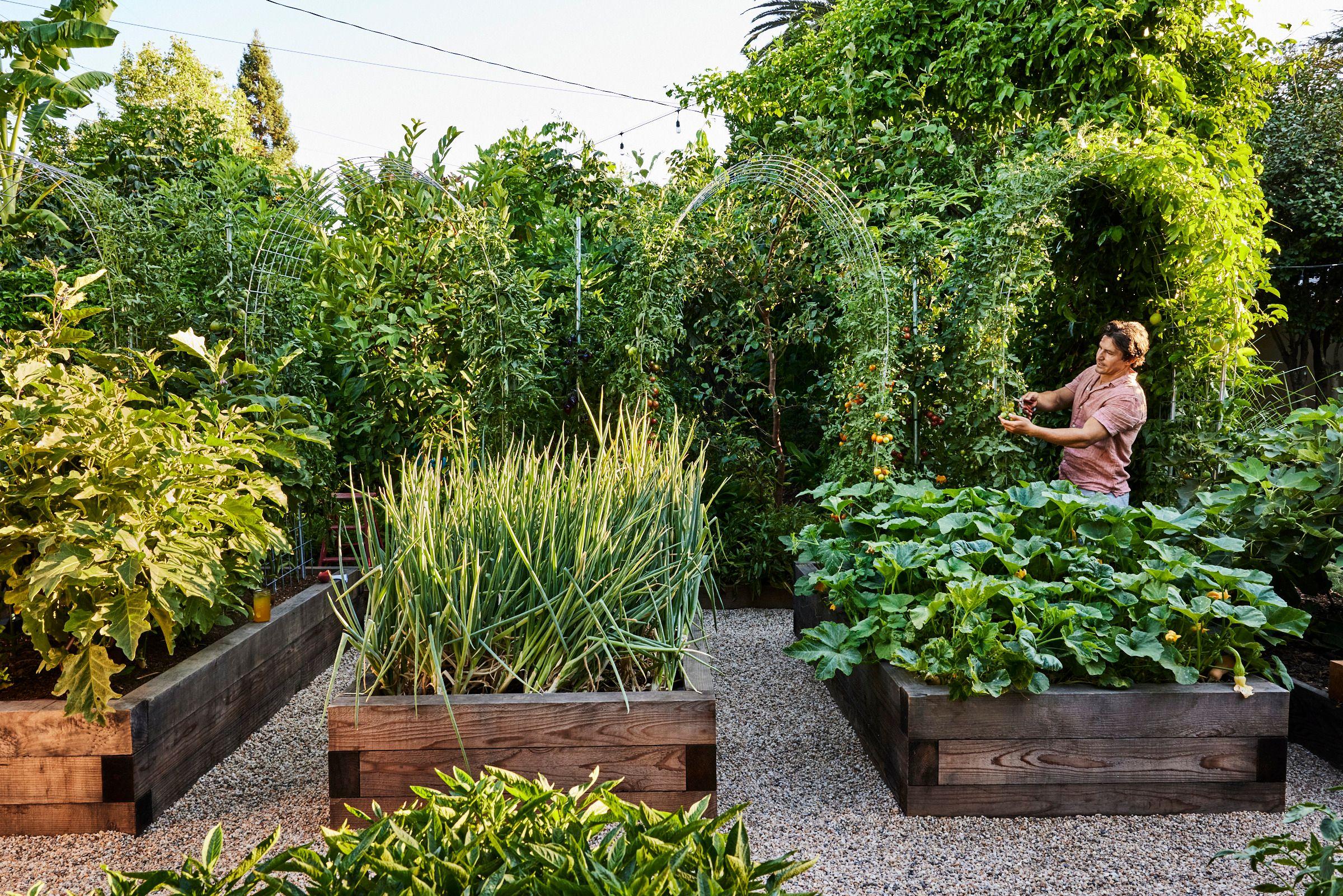Kyle Hagerty is undeterred by failure. When he started gardening 20-some years ago, his first edible crops—two tomato plants—ended in disaster: “The deer got to them before I could,” he remembers. These days, his 6,500-square-foot home garden in Sacramento shows off all he’s learned since then—providing enough fresh food for him and plenty to share with his coworkers (he’s a full-time firefighter). Here are his top tips for getting a big harvest out of any size kitchen garden.
Kyle Hagerty is a gardener with more than 20 years of experience in edible gardening who shares his tips on his popular account @urbanfarmstead.
1. Give Plants a Healthy Start
Hagerty grows many of his vegetables in his eight raised beds. “I love raised beds because I can fill them with whatever blend I want, unlike the native soil,” he says. His ideal mix for vegetables is a combination of topsoil, compost, and lava fines, which help oxygenate the soil.
Eva Kolenko
2. Grow Upwards to Maximize Space (and Prevent Disease)
Arched trellises Hagerty built out of bent hog paneling give climbing vegetables sturdy support—and beautify the space. They also provide crops with air circulation, which helps ward off powdery mildew.
Eva Kolenko
3. Plant for Continuous Harvest
“It’s so intense to have all your fruit ripen at one time,” says Hagerty. To avoid this, he practices successive sowing, and also plants multiple varieties of the same plant that ripen at different times in the season.
4. Add Flowers to Maximize Pollination
Near his many fruit trees, a bed planted with annual flowers serves a few purposes: It brightens up the area, provides easy access for fresh-cut flowers, and draws in pollinators—which ultimately results in more fruit.
Related
Eva Kolenko
5. Work Edibles Into Your Living Areas
Vegetables and fruits aren't limited to the raised beds. Hagerty also lined his bocce court with containerized blueberries, for instance. In another corner of the yard, he shaded a small stock tank pool with a subtropical fruit forest of avocado, banana, and mango trees.
Eva Kolenko
6. Propagate for Abundance
Hagerty frequently propagates plants from cuttings to increase his bounty each year. Case in point: pepino dulce, shown, which he grows in several spots throughout his yard. A fruit native to the Andes mountains, it tastes something like honeydew melon.
Hagerty’s favorite pest-control method? “Spending time with my plants,” he says. That way, any problem is caught before it’s a catastrophe.
Eva Kolenko
Eva Kolenko
Eva Kolenko
7. Never Stop Experimenting
By trialing different varieties of the fruits and vegetables you like best each year, you can figure out which ones do best in your zones and, of course, taste best. Year after year, Hagerty tries new cultivars of his favorite crops—including chiles, peaches, and loads of tomatoes. Here are some of his top picks:
Tomatoes: Of the 20 types of tomatoes he grows, he particularly likes ‘Sungreen’, a cherry tomato he calls "the most flavorful green-when-ripe tomato I’ve ever tasted," and ‘Striped German’, whose fruits can weigh up to 2-1/2 pounds each.
Chiles: Two of his favorites are ‘Flaming Flare’, a medium spicy Fresno variety, and ‘Carmen’, a high-performing sweet type.
Peaches: He grows ‘Eva’s Pride’ for midseason and ‘O’Henry’ for late-season.
Zucchini: He prefers the 'Sophy' hybrid for its upright habit and lack of the thorny hairs that cover most zucchini plants. “It's so much easier to handle and harvest,” he says.



